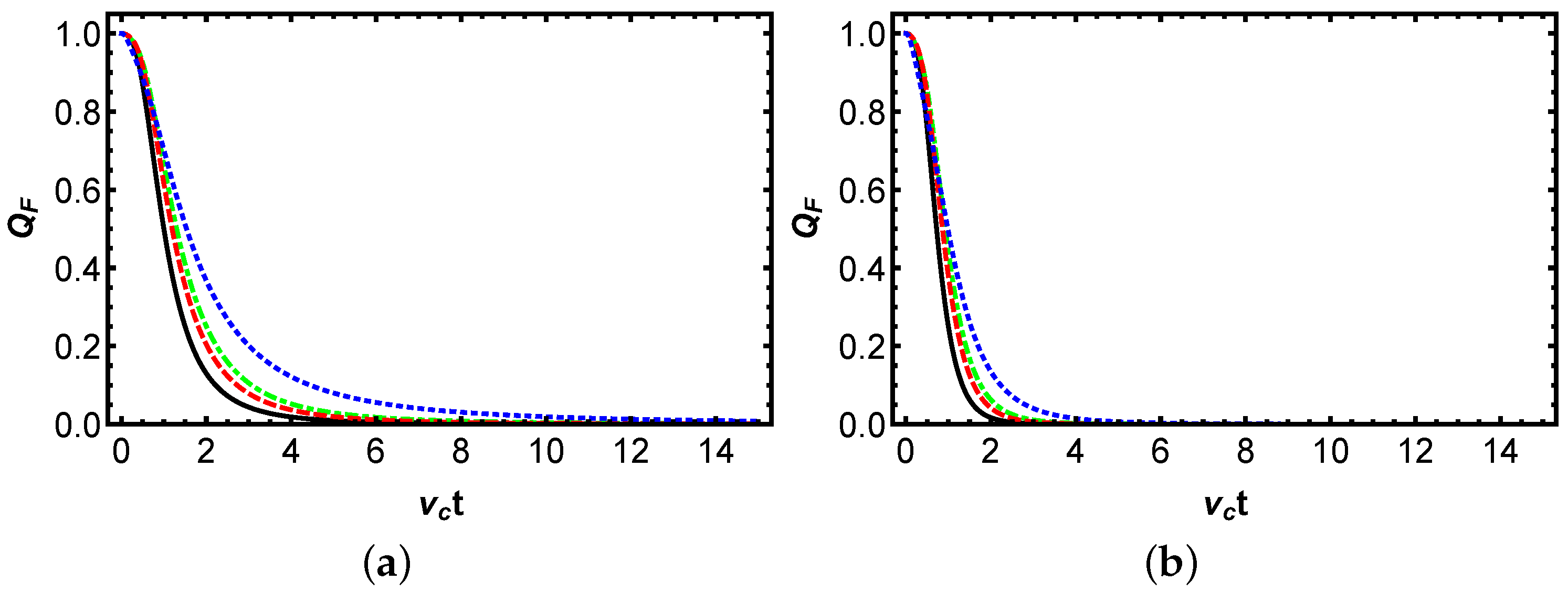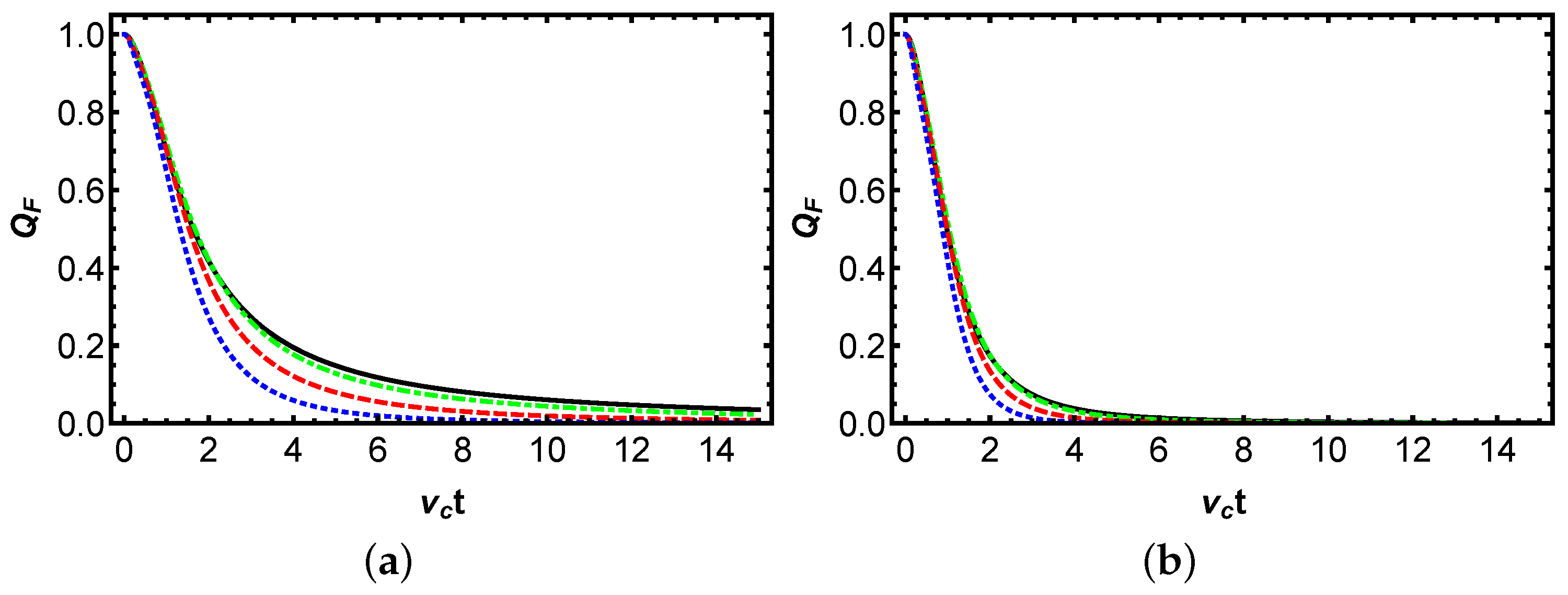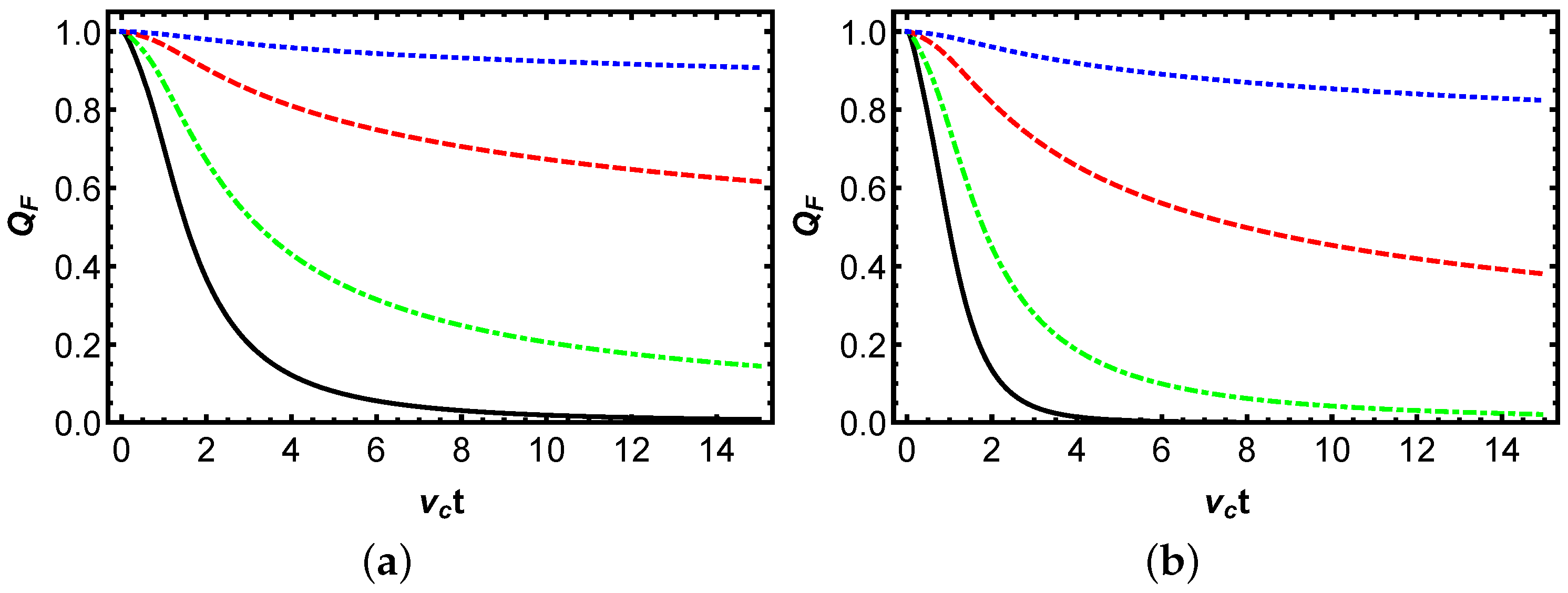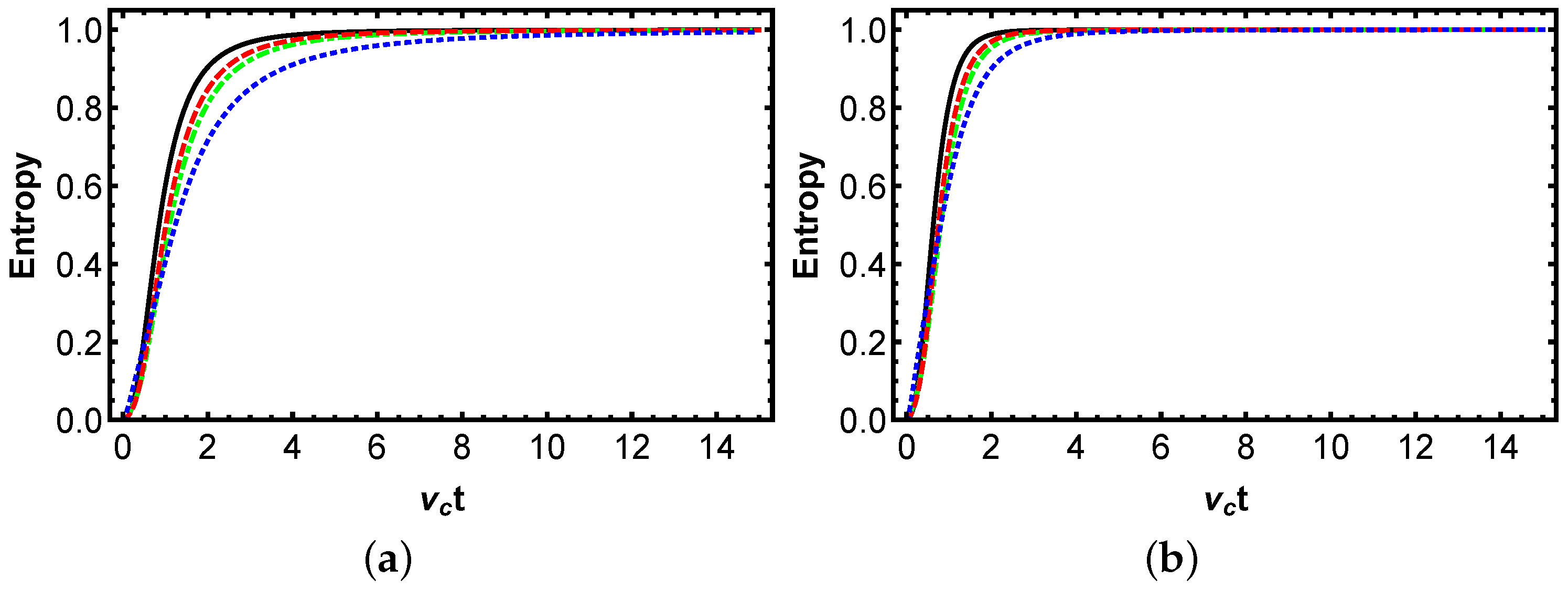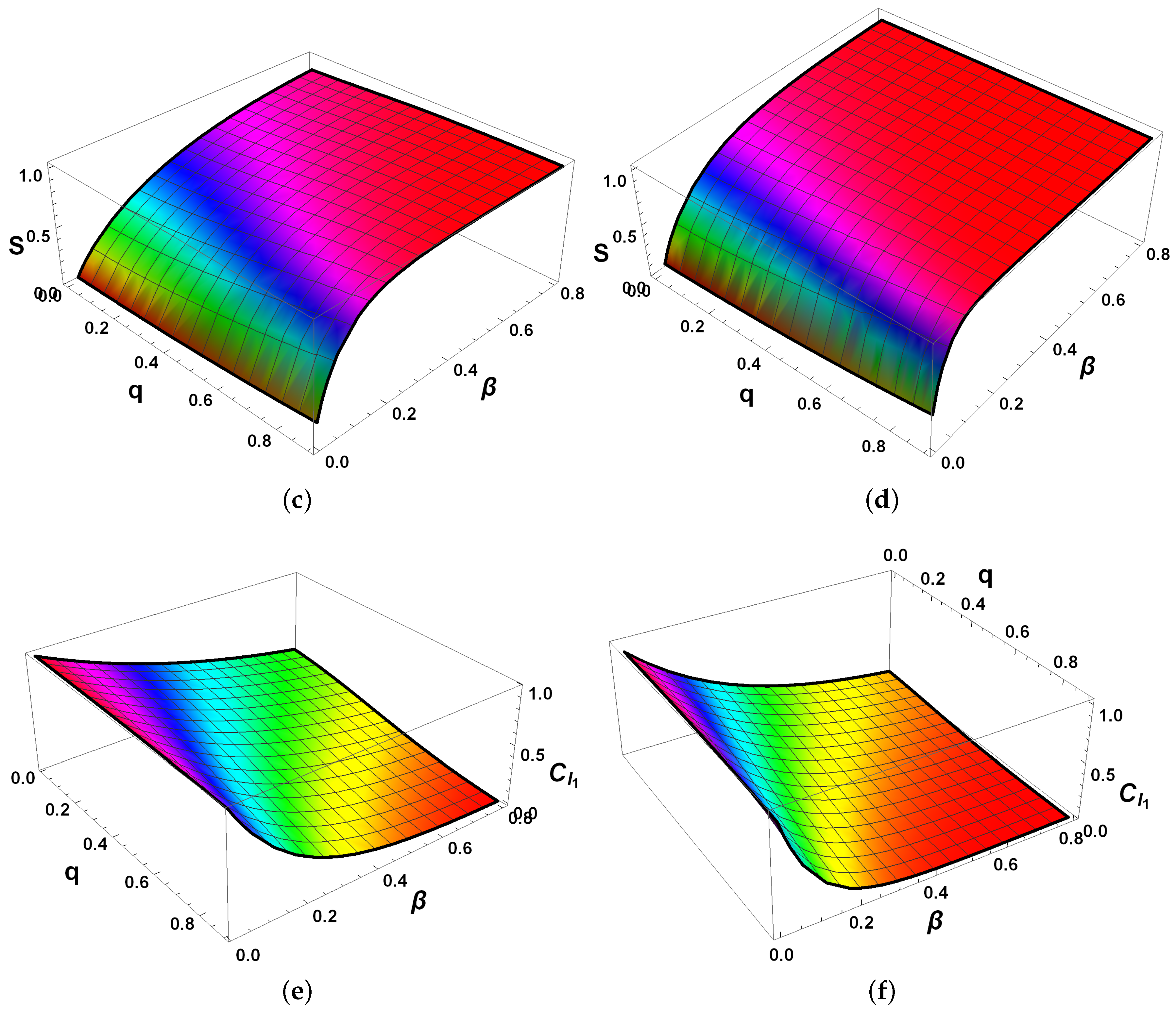1. Introduction
In quantum theory, the precision of parameter estimation (P-E) is crucial across numerous scientific and technological domains, where novel approaches to assessing parameter sensitivity often lead to significant breakthroughs and technological advancements. A primary goal in quantum estimation is to enhance and maintain resolution accuracy by determining the values of an unknown parameter that characterizes a quantum system. P-E has been extensively studied to address practical challenges such as loss and decoherence [
1,
2,
3,
4,
5,
6,
7]. Fisher information (FI), introduced by Fisher [
8], is a key concept in parameter estimation (P-E) theory. Within this framework, QFI, which quantifies a quantum state’s sensitivity to the parameter variations, is a fundamental concept. Quantum estimation theory provides methods to identify optimal measurements for systems, especially when the parameter of interest is not directly accessible. The quantum version of the Cramér–Rao inequality establishes a lower bound governed by QFI [
9], making QFI a central challenge to address. QFI represents the maximum information extractable from a specific measurement process for a given parameter. The QFI is an essential and fundamental quantifier extensively investigated across diverse physical contexts and frameworks. Recent studies have examined factorization dynamics linking QFI to quantum coherence, with both theoretical frameworks and experimental validations [
10]. These findings reveal how coherence influences QFI scaling, with implications for quantum-sensing applications. Advances in non-Hermitian quantum models demonstrate that QFI can achieve super-Heisenberg scaling for magnetic field estimation in finite systems [
11]. These findings highlight a dynamic interplay between Hermitian and non-Hermitian terms, enabling enhanced precision in dynamical quantum evolutions. A recent study on multiparameter qubit estimation introduced scrambling operations to address parameter uncertainty and incompatibility, enhancing the quantum Cramér–Rao bound [
12]. This method offers practical solutions for joint estimation, surpassing sequential approaches when parameter uncertainty is reduced. While this work examines single-parameter estimation, where QFI is a scalar quantifying sensitivity to
, in multiparametric scenarios the QFI forms a matrix
, with symmetric logarithmic derivatives
satisfying
for parameters
. Differences arise due to parameter incompatibility, where off-diagonal elements of the QFI matrix reflect trade-offs in simultaneous estimation, potentially requiring the quantum Cramér–Rao bound
(with weight matrix
W and
d parameters) rather than the simple scalar bound. For the two-qubit dephasing model here, extending to multiparametric estimation could reveal enhanced precision in local baths, as collective couplings might amplify incompatibility via correlated noise in
, leading to a non-commuting generator set and necessitating scrambling operations [
12] to approach the bound—contrasting the monotonic, decoherence-limited scalar QFI decay observed in our single-parameter case. Additionally, investigation applied QFI to cosmic qubits in non-Markovian environments for Hubble parameter estimation, distinguishing thermalization dynamics [
13]. These results underscore QFI’s utility in probing cosmological phenomena amidst environmental noise.
The purity of a quantum state, quantified as the trace of the density operator squared, provides a fundamental measure of its deviation from a pure configuration, with maximal purity indicating a coherent superposition free from statistical mixing and minimal purity signifying a fully mixed state in a given Hilbert space dimension. Mixedness, inversely related to purity, encapsulates the inherent uncertainty arising from ensemble averaging or environmental decoherence, and is alternatively gauged by the von Neumann entropy, which attains zero for pure states and its extremum for equiprobable mixtures, thereby serving as a cornerstone for assessing quantum information content. Recent investigations have elucidated the sensitivity of these metrics to variations in Planck’s constant, demonstrating that for Gaussian states, a reduction in this fundamental parameter diminishes purity and escalates entropy [
14]. Complementary approaches have derived tight bounds on von Neumann entropy solely from purity measurements, facilitating the operational quantification of entanglement and coherence in multipartite systems without necessitating complete spectral decomposition [
15]. In the realm of topological quantum matter, extensions of entanglement entropy to mixed states via convex-roof constructions preserve diagnostic capabilities for topological order, even under local noise, where mixedness modulates the persistence of long-range correlations [
16]. Moreover, novel entanglement measures based on reduction-induced variations in partial von Neumann entropy offer intuitive and computationally efficient tools for bipartite mixed states, bridging theoretical insights with practical applications in quantum resource theory [
17].
In quantum open-systems theory, the environmental reservoir is conventionally initialized in a thermal equilibrium state or a vacuum state. Nevertheless, progress in quantum reservoir engineering enables the preparation of nonthermal states. For example, squeezed reservoirs can be realized through Josephson parametric amplification in superconducting quantum circuits or via coherent manipulation of a trapped impurity within a double-well potential [
18,
19]. The application of nonthermal reservoirs has produced substantial insights in theoretical quantum investigations. A contemporary study [
20] analyzed the Wigner quasiprobability distribution for photon-added squeezed-vacuum states [
21,
22,
23], which holds relevance for quantum metrological protocols. Within non-Markovian open-system dynamics, squeezed reservoirs exert a pivotal regulatory influence [
24,
25,
26]. Moreover, inquiries into squeezed thermal reservoirs have broadened to encompass quantum thermodynamic processes [
27,
28,
29,
30,
31,
32]. Additionally, squeezed thermal and vacuum reservoirs profoundly affect diverse quantum phenomena, including abrupt entanglement decay [
25,
33], violation of Leggett–Garg type inequalities [
34], prolongation of quantum superposition lifetimes in Schrödinger-cat states [
35], and related effects [
36,
37,
38].
This work furthers our exploration of physical systems and physical processes that might result in high estimation precision. Specifically, we address this problem and discuss possible implications that might lead to useful techniques for maintaining and improving the precision of P-E. In this case, we examine the feasibility of maintaining and adjusting the QFI initially defined in a two-qubit system interacting with squeezed reservoirs. We demonstrate that by tuning the squeezing parameter, phase difference, and coupling strength, the QFI can be preserved and even improved during the dynamics. We demonstrate that long-term protection of quantum FI may be accomplished without being impacted by the decoherence effect by carefully choosing the model parameters.
The manuscript is organized as follows. In
Section 2, the physical dephasing model with the exact solution is introduced.
Section 3 is devoted to the dynamics of QFI and von Neumann entropy in a two-qubit system, locally subjected to spatially separated squeezed reservoirs or a common reservoir. A summary of our findings is presented in
Section 4.
3. Quantum Fisher Information and Purity
In this section, we examine the QFI to evaluate the sensitivity of a two-qubit system’s time-evolved states to a parameter
, encoded via a local unitary operation, under two distinct environmental interactions: (i) each qubit coupled to its own squeezed thermal bath, as governed by Equation (
6), and (ii) both qubits coupled to a shared squeezed thermal bath, as described by Equation (
9). The QFI serves as a pivotal metric in quantum metrology, quantifying the precision with which
can be estimated, thus shedding light on the impact of bath configurations on the precision of P-E. We start with the initial pure state
, where
x and
y are real coefficients satisfying the normalization condition
, yielding the initial density matrix
in the basis
. The parameter
is introduced through the unitary operator
, with the generator
, where
acts on qubit A and
is the identity on qubit B. The QFI, denoted
, is calculated using the formula
where
and
are the eigenvalues and eigenvectors of the time-evolved state
. In order to study the purity of the two-qubit states in the dephasing model, the von Neumann entropy is employed as a fundamental quantifier, defined as
where it measures mixedness by vanishing for pure states and achieving mixed two-qubit configurations for nonzero entropy value. For the time-evolved density matrices
and
, this entropy is derived from their spectral decompositions, revealing how the temporal degradation of state purity induced by interactions with squeezed thermal reservoirs. Within this quantum open-system framework, the entropy evolution elucidates how reservoir-squeezing parameters regulate coherence dissipation, manifested through the decoherence function
that governs off-diagonal decay, consequently influencing the overall mixedness.
Figure 1 illustrates the temporal evolution of the QFI in a two-qubit system subjected to pure dephasing due to interactions with squeezed-vacuum reservoirs, initialized in the pure entangled state
. The figure comprises two panels: (a) depicts the dynamics under local reservoir couplings and (b) shows the case of collective reservoir coupling. In both panels, the QFI is plotted against the dimensionless time
, with curves corresponding to different phase differences
. Solid is for
, dot-dashed is for
, dashed is for
, and dotted is for
, with fixed parameters
and
. In
Figure 1, phase differences
,
,
, and
illustrate the transition from minimal (
) to maximal (
) protective effects, with intermediates highlighting tunable control; fixed
and
. The QFI reaches its maximum value at
, reflecting the optimal sensitivity of the pure entangled state to phase variations. In both panels, the QFI exhibits monotonic decay from its initial value toward zero as time progresses, driven by dephasing from the squeezed reservoirs, resulting from the exponential suppression of off-diagonal elements in the density matrix, governed by the decoherence factor. The hyperbolic terms involving
q and the trigonometric dependence on
modulate the effective noise strength, allowing squeezing to either amplify or mitigate decoherence compared to an unsqueezed thermal bath. The dependence on
reveals a tunable control mechanism. When
, the QFI decays most rapidly, leading to accelerated loss of coherence, whereas at
, it decays most slowly, with intermediate values like
and
showing decay rates between these extremes. Comparing
Figure 1a,b, the collective coupling in (b) generally results in faster QFI decay across all
, particularly at longer times, where the collective case approaches asymptotic zero more rapidly. In the local bath scenario, off-diagonal elements like
decay with
, whereas in the shared bath, the exponent for
is
, causing faster erasure of the initial QFI. This amplification occurs because the shared bath correlates noise, enhancing the effective dephasing rate for the qubit state during dynamics. Physically, these results highlight the role of reservoir engineering in open quantum systems, which can be harnessed to extend the coherence time of entangled states, thereby enhancing the quantum advantage in metrological tasks and implying a lower Cramér–Rao bound for estimating
. Notably, for the specific initial state considered, independent local baths preserve QFI better than a shared bath, underscoring the importance of aligning the environmental configuration with the quantum state’s symmetry.
Figure 2 presents the temporal dynamics of the QFI for a two-qubit system undergoing pure dephasing with parameters
. The figure is divided into two panels: (a) illustrates dynamics under local reservoir couplings, where each qubit interacts with an independent squeezed bath, and (b) depicts collective coupling, where both qubits share a common bath. In both panels, QFI is plotted against the dimensionless time
. The curves correspond to varying squeezing parameters
q. Solid is for
, dot-dashed is for
, dashed is for
, and dotted is for
, with fixed coupling strength
and phase difference
.
Figure 2 varies
,
,
, and
at fixed
and
to span low-to-high squeezing strengths, modulating effective noise suppression. Both panels show QFI decaying monotonically to zero due to dephasing, driven by the decoherence factor
. The squeezing parameter
q modulates decoherence: at
, QFI decays slowly, as minimal squeezing offers limited noise suppression, delaying coherence loss. When
, QFI decay is faster, with stronger squeezing; intermediate
and
yield graded decay rates, reflecting the increasing suppression of
via the
term. Panel (b) exhibits faster QFI decay than (a) due to the collective bath’s enhanced dephasing effect. These findings highlight reservoir engineering’s role in quantum metrology, where higher squeezing mitigates decoherence, tightening the Cramér–Rao bound for
-estimation and that local baths outperform collective ones for this state, emphasizing the need to tailor environmental interactions to the qubits’state.
In
Figure 3, the time evolution of the QFI for a two-qubit system QFI is plotted against dimensionless time
under pure dephasing for various values of the coupling strengths
. The solid for
, dot-dashed for
, dashed for
, and dotted for
, with fixed squeezing parameter
and phase difference
. In
Figure 3,
,
,
, and
at fixed
and
capture weak-to-strong coupling regimes, where low
mimics near-isolated evolution and higher
amplifies bath-induced dephasing. Both panels of the figure demonstrate a monotonic decrease of the QFI to zero, driven by dephasing induced by the decoherence factor
. The coupling strength
regulates the intensity of dephasing. A weak
results in the slowest QFI decay by limiting bath-induced phase noise, thereby preserving QFI; a strong
(dotted) accelerates decay by amplifying noise through an increased
; intermediate values
and
yield progressive decay rates, aligning with the linear dependence of
in
. Panel (b) exhibits a faster QFI reduction compared to (a), as collective coupling enhances dephasing, where off-diagonal elements such as
decay as
versus
in the local configuration. These findings highlight the influence of reservoir engineering on quantum metrology, where a weaker system–bath coupling reduces decoherence, improving the Cramér–Rao bound for
-estimation and sustaining measurement precision against environmental noise.
Figure 4 depicts the time-dependent von Neumann entropy
S in a two-qubit system under pure dephasing in squeezed-vacuum reservoirs at zero temperature, initialized in the Bell state. The
Figure 4a,b show the entropy evolution for local and collective couplings, respectively, plotted against dimensionless time
with curves for varying phase difference
. The function
S starts at 0 for the pure initial state and rises monotonically toward 1, indicating increasing mixedness due to dephasing that affects off-diagonal coherences governed by
. Interestingly, the phase
modulates the rate, with
yielding the fastest entropy growth via enhanced noise alignment, while
minimizes it by quadrature suppression, and intermediate values show transitional rates. Furthermore, the panel (b) exhibits quicker entropy accumulation than (a), as collective noise correlates fluctuations to amplify dephasing during the dynamics. Physically, this highlights how phase tuning in engineered reservoirs controls purity degradation. Compared to QFI, which quantifies phase sensitivity and decays inversely with
S, high entropy correlates with low QFI, as mixedness diminishes metrological utility.
Figure 5 presents the temporal von Neumann entropy dynamics for the same initial state versus
with varying squeezing
q at
and
. We can observe that the function
S increases from 0 to approach 1, with lower
q accelerating growth due to insufficient noise reduction, whereas higher
q slows it, and mid-range
q produces intermediate increases reflecting hyperbolic modulation in
. In contrast to QFI, which decreases more rapidly at low squeezing parameter
q, the rise in von Neumann entropy
S exhibits an inverse correlation with QFI’s decline, underscoring that
S quantifies the degree of purity, whereas QFI reflects the loss of extractable information.
Figure 6 illustrates von Neumann entropy versus
for varying coupling
with
. It is observed that the von Neumann entropy
S rises monotonically from a pure state to maximum mixing, with higher coupling strength
accelerating this increase through enhanced
scaling, lower
slowing it by reducing bath interactions, and intermediate
values producing a range of intermediate rates. Physically, this highlights the dominant role of coupling strength
in determining dephasing intensity, where a minimal
approximates isolated quantum evolution, preserving coherence. In relation to QFI, the rise in entropy inversely correlates with QFI’s decline, as increased coupling reduces sensitivity while boosting mixedness, though low
in local setups optimizes both entropy and QFI, facilitating metrological precision. The selections of the parameters not only demonstrate the monotonic, decoherence-limited QFI decay but also underscore optimal configurations for preserving metrological sensitivity in local versus collective baths.
The observed preservation of QFI under optimal reservoir parameters—such as higher squeezing q, , and weaker coupling in local bath configurations—directly enhances the precision of estimating , as dictated by the quantum Cramér–Rao inequality, which bounds the variance , where M is the number of measurements. In the local bath case, the slower decay of off-diagonal terms (e.g., for ) maintains higher QFI values over longer , potentially reducing the estimation error by up to a factor of 2 compared to collective couplings, where decay is amplified (e.g., ). This suggests practical advantages for quantum-sensing protocols, where squeezed reservoirs could extend the operational timescale for phase estimation in noisy environments, outperforming unsqueezed thermal baths by suppressing the effective noise strength. Conversely, suboptimal parameters (e.g., or strong ) accelerate QFI loss, widening the Cramér–Rao bound and limiting metrological sensitivity, as evidenced by the inverse correlation with von Neumann entropy S, where increased mixedness erodes the quantum advantage.
Figure 7 (
) and
Figure 8 (
) reveal the tight mutual relations among QFI, von Neumann entropy
S, and
-norm coherence
. In the local bath configuration, moderate
and suitable
q yield extended regions of high QFI and high
accompanied by low
S, with this preservation effect significantly enhanced under the optimal phase difference in
Figure 8, demonstrating effective mitigation of coherence loss and sustained metrological usefulness with minimal mixedness. In contrast, collective couplings exhibit broader and more rapid degradation across the parameter space, resulting in low QFI, low
, and high
S even for moderate parameters. The inverse correlations are evident throughout both figures—decoherence drives the exponential loss of off-diagonal elements (
decay), which in turn increases mixedness (
S rise) and erodes parameter sensitivity (QFI drop)—consistent with the proportionality of
and
.
